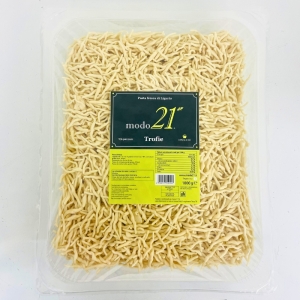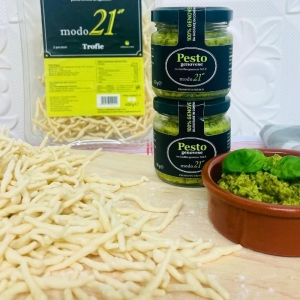Fresh Trofie (ligurian pasta) 1kg
![]() By buying this product you can collect up to
1
point
By buying this product you can collect up to
1
point
Fresh pasta typical of Ligurian tradition.
They originate in the Golfo Paradiso area, in that stretch of coastline - and relative hinterland - between Genoa and the Portofino promontory, i.e. between the towns of Bogliasco and Camogli. Trofie pasta has a twisted shape and the average length does not exceed 5 centimetres.
Fresh trofie are made from soft wheat, semolina and water, without eggs. Their classic sauce is Genovese pesto, and pieces of potatoes and fresh green beans can also be added if desired. It is a very versatile format, in fact outside the region they are now used as short pasta for a wide variety of recipes.
Our advice is to calculate at least 150 grams of trofie per person.
Did you know that we also have the 400gr pack? It can be purchased in our DINNER SAVERS >>
Safest Ways To Pay





Delivery services suited to your needs


TROFIE
Trofie pasta with pesto is perhaps the best known Ligurian pasta dish (together with trenette al pesto) but few know that the spread of this format outside their typical production area is relatively recent, even in Genoa...
The history of Ligurian trofie
The trofie we know today are a pasta made of wheat flour, without eggs, they have a curled and narrow shape and are less than 5 centimetres long: however, in past centuries different formats were identified with this name in different parts of Liguria, for example in Genoa, the term 'trofie' was used for potato gnocchi, or rather 'troffie' with two effe. So there are those who argue that what we now call trofie, this type of short pasta, should historically be called 'trofiette' to distinguish it from potato gnocchi. Trofie pasta has also always been made with chestnut flour or wholemeal flour and in this case is known as 'trofie avvantaggiate'.
Trofie pasta originated in Golfo Paradiso, which is a small area of the Riviera di Levante between the city of Genoa and the promontory of Portofino. Here, at least until the mid-20th century, trofie remained confined to home use in the family as fresh pasta. Then, thanks to mechanisation (the first production took place in Sori, hence the times they are also known as 'trofie di Sori' but vie for supremacy with nearby Recco) and the creation of the dry pasta version, trofie were also exported outside the region.
How to make trofie at home by hand
Homemade trofie is made with 00 wheat flour and lukewarm water (without salt, oil or eggs). The proportion is 50 milligrams of water for every 100 grams of flour. After the dough is ready, it is kneaded in small portions at a time. The dough should always remain moist. Tearing off small pieces of dough, these are slid and rubbed on the work surface with the palm of the hand, so that they are stretched into clumps of dough. When the piece of dough is long enough, to give it the twisted shape, one must still rub it but not by going up and down as was done to stretch the dough. Instead, the hand must only slide backwards: the dough must slowly come out externally under the little finger and the hand must remain at a 45° angle on the work surface. It is a long job and takes a lot of experience, and it has been calculated that it takes at least an hour to make a kilo of trofie by hand. To prevent the already-formed trofie from sticking together while you continue making the others, remember to dust with semolina flour.
How to season trofie
The classic seasoning for trofie is pesto genovese, to which you can also add chopped potatoes and fresh green beans to taste. For different cooking times, it is best to throw the vegetables into boiling salted water a few minutes beforehand and then finish boiling them together with the fresh pasta, and usually trofie has a cooking time of about 4 minutes. Calculate about 40 grams of potatoes each and 30 grams of green beans.
Genovese pesto is a sauce that should not be reheated at all, so the trofie should be dressed directly in the dish, if necessary you can dilute the sauce with a little cooking water to make it creamier. For a serving of trofie use at least 60 grams of fresh pesto.
Because of their great versatility, trofie have been used for a long time to make recipes that are not exactly typical of Liguria. Trofie are ideal with both drier and creamier sauces, making them great for all seasons. For example, you can find dishes such as 'trofie with courgettes and prawns' or 'trofie with speck and walnuts'. While this may turn some people's noses up, for us it is a source of pride to discover how much everyone likes this traditional pasta format from our land.
How to cook trofie
Trofie pasta is usually cooked in boiling water for a few minutes and then dressed directly on the plate with the chosen sauce. As we have already mentioned, trofie is a very versatile type of pasta that can also be sautéed in a pan or baked in the oven. If you are going to try baking trofie pasta in the oven, the advice is to use it after cooking it in plenty of salted water: it must be just al dente to get a great end result.
A recipe to try right away: trofie pasta with lemon-scented gilthead bream sauce
- 600g fresh trofie
- 400g gilthead bream fillets
- 10 cherry tomatoes
- 200ml white wine
- 5g pine nuts
- two sprigs of fresh marjoram
- lemon zest (as needed)
- one garlic clove
- olive oil and salt (to taste)
Remove the skin and bones from the gilthead bream fillets, dice them large enough so they do not fall apart during cooking. Toast the pine nuts in a frying pan and, depending on your taste, decide whether to leave the pine nuts whole or to chop them. Fry the garlic, pine nuts and sea bream together. Deglaze with white wine and add salt to taste.
The sea bream sauce is ready in a few minutes after you have blended the fish with the wine. Add the cherry tomatoes only at the last, at the moment of serving, with the grated lemon zest and freshly chopped marjoram.
For even tastier cherry tomatoes, we recommend blanching them just long enough to remove the skin easily. Then season them with oil and herbs (e.g. basil) and let them marinate while the pasta is cooking.
Wine pairing with trofie
When choosing the wine to accompany trofie, the greatest variable to take into account is the sauce. Therefore, with the traditional dish of trofie with pesto, we recommend the pairing with local white wines - such as Bianchetta Genovese or Pigato - while with more full-bodied fish sauces (with a good savoury base of anchovies, for example) you can bring to the table a typical Genovese red wine such as Ciliegiolo; for meat or more rustic sauces - such as sausage and mushrooms - a good choice could be Rossese.
6 meals

You might also like


























